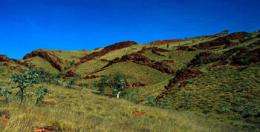(PhysOrg.com) -- A new geological study which took place in the Pilbara region of Western Australia brings us one step closer to understanding more precisely the timing of when the primordial earth crust was formed and its composition.
The study, published online this week in the prestigious journal Nature Geoscience, was led by Research Associate, Dr Svetlana Tessalina, of the GEMOC ARC National Key Centre, Department of Earth and Planetary Sciences at Macquarie University. The team also included Prof. Pascal Philippot from the Institut de Physique du Globe de Paris, and colleagues from the Geological Survey of Western Australia and Switzerland.
The earliest history of Earth remains obscure because the oldest preserved terrestrial rocks are 4.03 billion years old, leaving a window of almost 500 million years after Earth’s formation at 4.567 billion years with very little recorded history. Nowadays, however, advances in geochemistry allow us to decipher the isotopic signals that keep the memory of older rocks.
Relics of little deformed and altered ancient rocks are present in some parts of the world, such as the Pilbara Craton in Australia. To go back in time and better understand the early history of our planet, Tessalina and her colleagues looked at the North Pole Dome site of the Pilbara Craton which contains some of the oldest terrestrial rocks and fossils. The remnants found there provided the vital clues indicating some geochemical fingerprints of ancient lithosphere.
Tessalina and her colleagues collected samples including volcanic, sedimentary and hydrothermal rocks from the area - both drilled and from outcrops. The rocks and sediments were then analysed for their isotopic composition. The results showed that the analysed rocks are 3.49 billion years old as was previously thought. However, they were contaminated by much older crustal component during their formation. Geochemical modelling shows the crustal component to be at least 4.3 billion years old.
Until now, the physical remnants of such an old crust have not been found on the Earth’s surface - except for rare zircon crystals which are preserved in another area of Western Australia called the Yilgarn Craton. These crystals have revealed a surprising amount about early Earth conditions, but only tell one side of the crustal evolutionary story - that of granitic crust. The results show that there was another side to the early Earth story - a mafic crustal component.
Based on their findings, Tessalina and her colleagues believe that the evolution of the Pilbara and possibly other Archean cratons began much earlier than recorded by their physical rocks record alone would indicate.
Dr Tessalina said the findings provide further evidence that the crust on Earth started to form between 4.3 and 4.5 billion years ago. This crust may represent a part of the early “skin” covering what is widely considered to have been a magma-ocean early Earth. The preservation of geochemical relics of this ancient period of Earth history may help unravel part of the early history of our planet.
Provided by Macquarie University



















